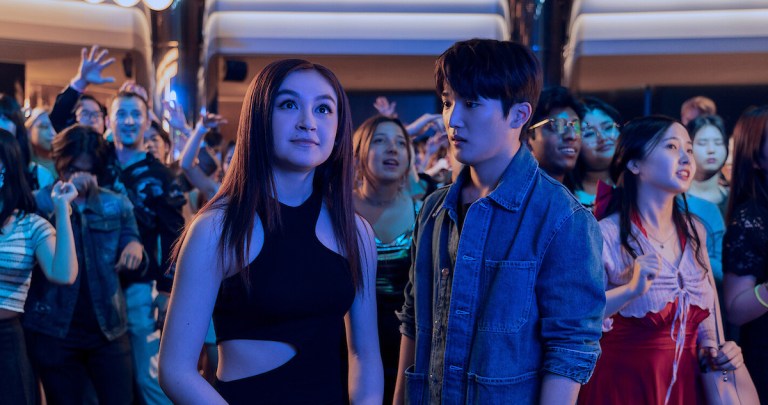How A Slow Reveal And Seemingly Minor Details Can Make Your Novel So Much Better
In this series, I’m reading Celeste Ng’s blockbuster debut novel Everything I Never Told You and discussing literary techniques I notice in each chapter.
By ![]() Robert Yune
Robert Yune

In this series, I’m reading Celeste Ng’s blockbuster debut novel Everything I Never Told You and discussing literary techniques I notice in each chapter. Obviously, this post contains spoilers for both EINTY and Star Wars: Episode IV, as well as minor spoilers for the prequels. For past installments: part 1: Characterization (which includes a link to an online excerpt of the novel’s first chapter), part 2: The Graceful Flashback, and part 3: Tension and Subplots.
This is the last double-header post, but I wanted to discuss chapters five and six together. I’m assuming that many readers are also aspiring writers, so I’m going to discuss the power of small details and the “Polaroid” method for revealing a character. Since Everything I Never Told You is twelve chapters long, we’ve officially reached the halfway point, and things in the novel’s plot are definitely heating up. Here’s one way Ng maintains the novel’s intensity:
1. Capture the Power of Small Details by Adding a “Paperclip”
I could probably write an entire post about details, since they’re so tricky for literary writers (and writers in general). After all, if someone said, “Hey, you should read this book. It’s full of good descriptions and details,” that’s usually not as compelling as, “I instantly fell in love with the characters and stayed up all night because I couldn’t wait to see what happened to them.” I’ve read a number of Important Works of Literature where the author spends an entire chapter describing the aroma of a samovar and the glint of light off a velveteen chaise lounge in a dimly lit study, and those kinds of detail make me cringe:
Elmore Leonard has this great quote: when asked about how he wrote novels that were so gripping, he replied, “I leave out all the parts readers skip.” One can only read so many details about motes of dust swirling onto an oaken desk in a dimly lit study before his or her eyes glaze over.
At the same time, including the right details is important: after all, they’re the best (and only) way to bring people and places to life on the page. I’ve always thought that was the main purpose of details, but today, this serendipitous Raymond Chandler quote popped up on my phone:
One of my fave bits of Raymond Chandler wisdom – why readers do care about description, even if they don’t know it. pic.twitter.com/p2FAAG4A5e
— Jonny Geller (@JonnyGeller) August 4, 2015
Chandler comes up with such a vivid and specific detail, seemingly off the top of his head, that we’re just as surprised as the paper clip man when his killer walks through the door. So, details can enhance the plot by serving as an author’s sleight-of-hand trick. More importantly, details can make the reader care about the victim: I can still picture the expression on his face (as well as his frustration at this weirdly specific task) long after I’ve finished that paragraph.
Also, to back up my earlier point about carefully choosing which details to include, notice how Chandler omits unnecessary information about the time period, the weather, and even the killer’s motivation—instead, he carefully describes something that resonates emotionally with the reader, and he does it in less than 140 words.
Here are some “paperclips” that stuck out in chapters five and six of EINTY. I think for something to count as a “paperclip,” it needs to pass a simple test:
- Is it small?
- Does it appear briefly?
- Does it have more than one function? (Chandler’s paperclip helps characterize a man and also distracts the reader until his killer walks through the door.)
Here’s a good example. This is a scene that happens after Marilyn has left her family. See if you can spot the paperclip:
“How is Marilyn?” Mrs. Allen asked. “She’s been away quite a while, hasn’t she? I do hope everything is all right.” Her eyes were excited and bright, as if—Nath thought—she might get a present.
“We’re holding down the fort,” James said.
“How long will she be away?”
James glanced down at the children and hesitated. “Indefinitely,” he said. Beside him, Nath kicked Mrs. Allen’s gate with the toe of his sneaker. “Don’t do that, Nath. You’re leaving a scuff.”
Mrs. Allen peered down at them, but the children, in unison, looked away. Her lips were too thin, her teeth too white. Under the heel of Lydia’s shoe, a wad of bubble gum stuck her to the concrete like glue. Even if she were allowed, she thought, she could not run away.
“You two be good now, and your mother will be home soon, isn’t that right?” Mrs. Allen said. She shifted her thin-lipped smile to James, who didn’t meet her eye. “Our groceries must be melting,” James said […]“It’s nice seeing you, Vivian.” He tucked the paper sack under his arm and took each of the children by a hand and turned away, and the gum under Lydia’s shoe stretched and snapped, leaving a long, dried-out worm on the sidewalk” (129).
I love the subtlety in this scene: Ng never says that Mrs. Allen is thirsty for gossip, but Nath can sense it even if he doesn’t quite understand, and a smart reader can figure out her intentions.
However, the “paperclip” is that wad of gum on Lydia’s shoe. It’s a great paperclip because it’s one of those weird details that sticks out in a traumatic moment.
It appears briefly. In terms of function, the gum emphasizes the family’s emotional turmoil and when it snaps, the tension in the scene also snaps and then dissipates, which is another small-but-useful function.
It’s worth noting that a “paperclip” doesn’t need to be a tangible, physical object.
Here’s an edited passage from chapter 5:
When he heard the station’s late-night sign-off, he would slip the scraps of Marilyn’s note into the envelope and tuck it back into his shirt pocket. Then he tiptoed into the living room, where the children lay curled up together on the floor by the sofa. James carried first Lydia, then Nath, to bed. Then—because, without Marilyn, the bed felt too empty, like a barren plateau—he returned to the living room, swaddling himself in an old crocheted afghan on the sofa until he finally fell asleep. In the morning, it all began again.
Now, here’s the actual passage:
When he heard the station’s late-night sign-off and the national anthem begin to play, he would slip the scraps of Marilyn’s note into the envelope and tuck it back into his shirt pocket. Then he tiptoed into the living room, where the children lay curled up together on the floor by the sofa, illuminated by the test pattern on the television. The Indian at the top of the screen glared as James carried first Lydia, then Nath, to bed. Then—because, without Marilyn, the bed felt too empty, like a barren plateau—he returned to the living room, swaddling himself in an old crocheted afghan on the sofa and studying the circles on the screen until the signal cut off. In the morning, it all began again (127).
Like Chandler’s paperclip, the Indian head has no effect on the plot. It only appears in this one paragraph. Unlike the gum in the previous example, it doesn’t heighten emotion, but it is useful because it’s an authentic detail that reminds the reader of the time period. The fact that the Indian is glaring also enhances the moody, late-night atmosphere while helping to show how dazed James is.
The last example I’d give is also from chapter six, when Nath meets Jack. Remember how Jack offers Nath candy when he tries to comfort him? (It’s a long passage, but it’s on page 131 if you’re reading along.)
The Swedish fish are small, only appear for five minutes at most, and there’s some kind of magic in the combination of sensory detail (especially taste, which isn’t appealed to often in this book) and the intense freakout that Jack’s comments causes. Also, the Swedish fish give Jack and Nath, former enemies, a reason to interact in the first place.
You can try it yourself: read that scene without the Swedish fish and the interaction feels functional and plot-driven, like the author decided this interaction was necessary and conveniently made the conversation/confrontation happen.
2. Shake it Like a Polaroid Picture…to Reveal an Important Character. Or, What do Hannah and R2D2 Have in Common?

I’ll admit: when I started reading this book, I didn’t understand why Hannah was in it. In the first chapter, she’s one of five characters the reader has to keep track of, and she kind of easily fades into the background during all the drama. The second chapter is a flashback to before Hannah was born, and in the third chapter, she appears just often enough during the funeral to remind you that she exists.
In chapter four, another flashback chapter, Hannah doesn’t exist yet. However, in chapter five, Hannah gets a lot of screen time and her quiet, observant presence is a nice contrast to her family, who are alternately furious, grieving, and horny. Also, for the first time, one of her decisions matters—when she prevents Nath from fighting with Jack, we get the sense that the plot has been changed a little.
By the end of chapter five, I still wasn’t sold on Hannah. She still didn’t seem to be doing anything valuable and could probably be replaced with an even minor-er character. However, then chapter six came along and I realized that her mere existence created a major plot point—Hannah is the reason Marilyn returns to James, Lydia, and Nath, after all.
I’m not sure why I didn’t see it coming: maybe it was because Ng included so many other plot and character-related details to distract me. At any rate, I was impressed by the way the author slowly revealed Hannah (kind of like a Polaroid photo slowly developing throughout the novel’s first half), and Ng used pacing well to keep Hannah visible but mostly waiting in the wings until she was needed.
I’ve been thinking about minor characters a lot, and two “minor” characters instantly came to mind: R2D2 and C3PO. I know my life won’t be worth much after I write this, but I’ve never been particularly fond of either droid. I grew up watching the movies, and I think the droids’ charm wore off by the 70th time I finished the trilogy. Also, my view is probably tainted by the prequels, where R2D2 is basically a Swiss army knife and has abilities that are oddly absent in the original trilogy. Or, R2D2 had an impressive array of combat and flight abilities in the prequels and opted not to use them in episodes IV-VI for some reason, which means he’s basically an asshole.
Another reason I didn’t like either droid is because, having not seen the movies in about a decade, I thought George Lucas just kind of stuck them in the films to provide comic relief, which makes them the storytelling equivalent of a spare tire that has to be lugged around.
That said, I rewatched Episode IV and realized that without R2D2 playing Princess Leia’s message, the entire trilogy doesn’t happen. (Actually, if C3PO doesn’t convince Owen to purchase R2D2, the entire trilogy doesn’t happen.) Later in the movie, R2D2 becomes more and more useful, as the whole point is to get him (and the Death Star blueprints) to the rebels. Etcetera.
Anyway, while I’m guessing that Hannah doesn’t help anyone destroy a Death Star, I’m curious to see if she plays a larger role in the novel now that her main plot purpose seems to have been revealed.
Here’s an exercise for you. Unlike the last two weeks, it’s not a writing prompt. However, I think the first step to creating great Chandler-esque “paperclips” in your own novel is to learn how to identify them in others’ work. Can you name the paperclips in chapter five of EINTY? I counted three…feel free to add your findings to the comments section. ![]()



